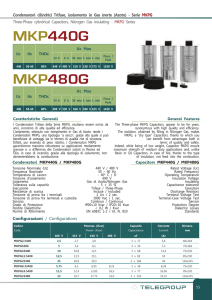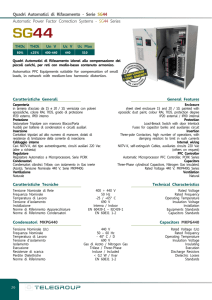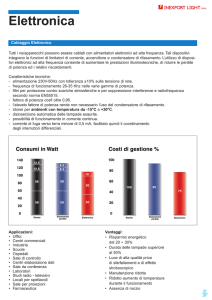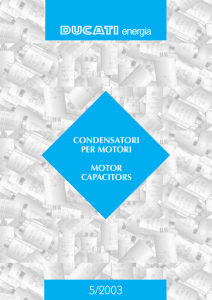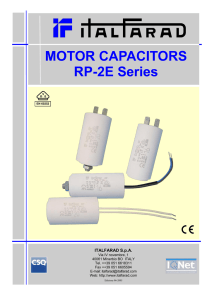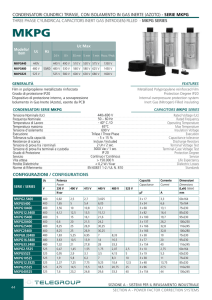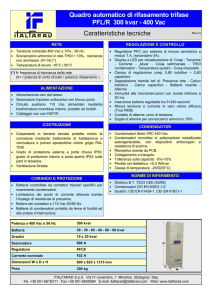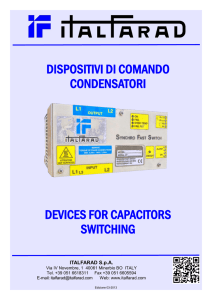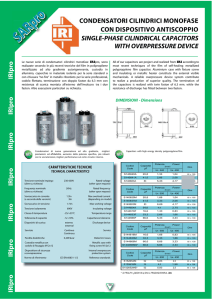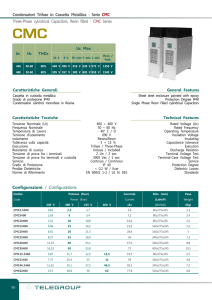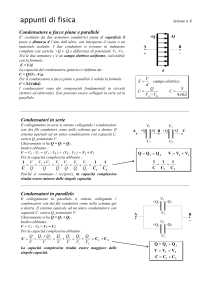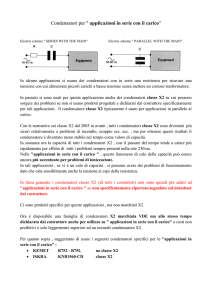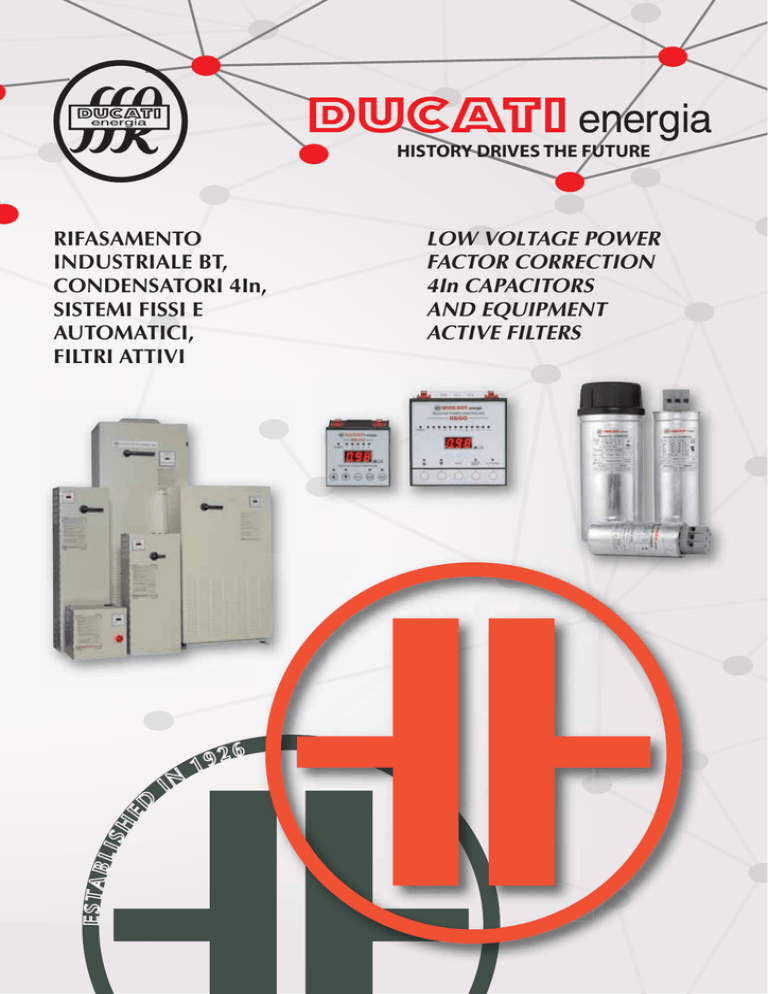
HISTORY DRIVES THE FUTURE
RIFASAMENTO
INDUSTRIALE BT,
CONDENSATORI 4In,
SISTEMI FISSI E
AUTOMATICI,
FILTRI ATTIVI
E S TA B
LIS
H
ED
IN
19
26
LOW VOLTAGE POWER
FACTOR CORRECTION
4In CAPACITORS
AND EQUIPMENT
ACTIVE FILTERS
Tecnologia
dei condensatori
Capacitors
Technology
INTRODUZIONE
INTRODUCTION
Ducati nasce nel 1926 introducendo per prima in Italia, e fra
le prime al mondo, condensatori per le apparecchiature di
radiotrasmissione prodotte da Guglielmo Marconi.
Da questa tradizione, che ha sempre visto Ducati
all’avanguardia nella tecnologia di elementi capacitivi, si è
giunti all’utilizzo innovativo del film PPM e PPMh e alla
nascita del condensatore 4In.
Le prestazioni superiori e le dimensioni ridotte rispetto alle
ormai obsolete soluzioni in carta e olio e in gas, rendono i
condensatori prodotti in PPM/PPMh il nuovo standard di
riferimento per il rifasamento industriale.
Ducati was founded in 1926 and was the first company in
Italy, and among the first in the world, to introduce capacitors
for the radiobroadcasting equipment produced by Guglielmo
Marconi.
Building upon this tradition, which has always seen Ducati in
the forefront of capacitor technology, the company has
developed the innovative PPM and PPMh film with 4In
capacitor.
Superior performance and reduced dimensions compared to
the by now obsolete paper and oil and gas solutions make
PPM/PPMh capacitors the new standard of reference for
industrial power factor correction systems.
Tutti i condensatori prodotti da Ducati Energia sono dotati di
un dispositivo di protezione conforme alle norme EN 608311/2. Questa protezione è stata ottenuta attraverso una
particolare tecnologia costruttiva, che in caso di guasto
disconnette i collegamenti per sovra-pressione, lasciando
integro l’isolamento verso la custodia e impedendo che il
condensatore possa scoppiare o bruciare.
Il dispositivo è stato studiato e dimensionato al fine di
rendere più efficace e tempestivo l’intervento sia con basse
sia ad alte correnti di cortocircuito (fino a 10.000 A).
All the capacitors manufactured by Ducati Energia feature a
protection device conforming to standards EN 60831-1/2. This
protection has been achieved by means of a special
engineering technology: if a fault occurs the connections will be
broken due to overpressure, leaving the insulation of the case
intact and preventing the capacitor from exploding or burning.
The device has been designed and dimensioned to ensure
more efficient, prompt operation with both low and high short
circuit currents (up to 10,000 A).
TECNOLOGIA PPMh/MKPh 4In
TECHNOLOGY PPMh/MKPh 4In
La continua ricerca nei laboratori Ducati Energia ha portato
allo sviluppo di un film in polipropilene con una speciale
metallizzazione, al fine di favorire il processo di
autorigenerazione e diminuire le perdite dielettriche.
L’innovativa metallizzazione permette al polipropilene uno
stress minore durante il funzionamento, quindi mantiene le
caratteristiche dielettriche per un tempo notevolmente più
lungo e allo stesso tempo consente prestazioni notevolmente
superiori sia in termini di corrente 4In che di tensione.
The continuous research conducted in Ducati Energia
laboratories has led to the development of a polypropylene
film with a special metallization, whose purpose is to favour
the self-healing process and reduce dielectric losses.
Thanks to this innovative metallization treatment, the
polypropylene is subjected to less stress during operation.
Therefore it maintains its dielectric properties for a
significantly longer time while delivering significantly better
performance in terms of both 4In current and voltage.
GAMMA LONG LIFE 4In
Questa innovativa gamma di condensatori per il rifasamento
industriale con elementi avvolti con film PPMh, si impone per
affidabilità, prestazioni e compattezza.
La più efficace autorigenerazione e le ridotte perdite
dielettriche permettono di ottenere durata e prestazioni in
tensione e corrente paragonabili ai condensatori in carta e
olio con ingombri ridotti.
Fanno parte di questa tipologia i condensatori appartenenti
alle famiglie:
LONG LIFE SERIES 4In
This innovative range of industrial power factor correction
capacitors featuring elements wound with PPMh film sets
new standards of reliability, performance and compactness.
More effective self-healing and reduced dielectric losses
make it possible to obtain a lifespan and performances in
terms of voltage and current that are comparable to those of
paper and oil capacitors while reducing size.
Capacitors of this type belong to the families:
➣ Series MONO
➣ condensatori monofase serie MONO
416.53
6
416.53 single-phase capacitors
Tecnologia dei
condensatori
in PPMh
Capacitor
Technology
PPMh/MKPh
TECNOLOGIA PPM / MKP
PPM / MKP TECHNOLOGY
La tecnologia del polipropilene metallizzato (PPM / MKP),
consiste nel depositare per evaporazione sotto vuoto un
sottilissimo strato di metallo su un lato del film di
polipropilene.
Gli elementi capacitivi costruiti con questa tecnologia vengono
ottenuti avvolgendo due film di polipropilene. Le armature del
condensatore sono costituite dalla metallizzazione dei due film
e il dielettrico dal film di polipropilene stesso.
Pregio principale dei condensatori con armatura metallizzata
è di essere autorigenerabili, di essere capaci cioè, di
ripristinare le proprietà elettriche al verificarsi di un corto
circuito fra le armature.
In conseguenza del ridotto spessore dell’armatura, la
corrente di corto circuito nella zona circostante il guasto, è in
grado di vaporizzare la metallizzazione, estinguendo
automaticamente il corto circuito, senza un’apprezzabile
riduzione di capacità o dispendio d'energia.
Metallized polypropylene technology (PPM / MKP) utilizes a
vacuum evaporation technique to deposit an extremely thin
layer of metal on one side of the polypropylene film.
The capacitor elements built using this technology are
obtained by winding two polypropylene films. The capacitor
plates consist in the metallized surface of the two films and
the dielectric is the propylene film itself.
The main advantage of capacitors with metallized plates is
their self-healing capacity. This means that they are capable
of restoring their electrical properties following the
occurrence of a short circuit between the plates.
Due to the reduced thickness of the plates, the short circuit
current generated in the area of a fault is capable of
vaporizing the metal coating; the short circuit is thereby
automatically extinguished without an appreciable reduction
in capacitance or expenditure of energy.
GAMMA EXTRA DUTY (XD) E STANDARD LIFE (SL)
In questi condensatori l’agente impregnante è rappresentato
da un particolare tipo di resina. Ducati Energia ha messo a
punto una composizione di resina ecocompatibile ad alta
stabilità dielettrica, che consente di rimuovere totalmente
ogni possibile rischio di presenza di molecole d’aria e acqua
all’interno del condensatore. Fanno parte di questa tipologia
i condensatori appartenenti alle famiglie:
EXTRA DUTY (XD) AND STANDARD LIFE (SL) SERIES
In these capacitors the impregnating agent is a special type
of resin. Ducati Energia has developed an ecofriendly resin
composition displaying high dielectric stability, which
completely eliminates every possible risk of air and water
molecules being present inside the capacitor. This category
includes the capacitors belonging to the families:
➣ condensatori trifase serie MODULO XD
➣ Series MODULO XD
416.46 (XD)
416.46 three-phase capacitors (XD)
➣ condensatori trifase serie MODULO XD Mini 416.12 (XD)
➣ Series MODULO XD Mini 416.12 three-phase capacitors (XD)
➣ condensatori monofase serie FLOPPY CAP 416.30 (SL)
➣ Series FLOPPY CAP
7
416.30 single-phase capacitors (SL)
Definizioni
Definitions
Tensione nominale (Un)
È il valore massimo efficace della tensione alternata sinusoidale
per la quale il condensatore è stato progettato.
Rated voltage (Un)
This is the maximum effective value of the alternating sinusoidal
voltage for which the capacitor was designed.
Potenza nominale (Qn)
È la potenza reattiva erogata dal condensatore con tensione e
frequenza nominale applicate.
Rated power (Qn)
This is the reactive power delivered by the capacitor at the rated
voltage and frequency applied.
Capacità nominale (Cn)
È il valore che permette di erogare la potenza nominale,
applicando ai terminali la tensione e frequenza nominale.
Rated capacitance (Cn)
This is the value which permits delivery of the rated power
applying the rated voltage and frequency to the terminals.
Corrente nominale (In)
È il valore efficace della corrente alternata che circola nel
condensatore quando alla capacità nominale si applica la
tensione e frequenza nominale.
Rated current (In)
This is the effective value of the alternating current that
circulates through the capacitor when the rated voltage and
frequency are applied at the rated capacitance.
CONDIZIONI DʼESERCIZIO
OPERATING CONDITIONS
A differenza della maggior parte delle apparecchiature
elettriche, i condensatori per rifasamento, ogni volta che sono
energizzati, operano in continuità a pieno carico, o a carichi che
si discostano da questo valore solo come conseguenza delle
variazioni di tensione e di frequenza.
Le sovrasollecitazioni ed i surriscaldamenti abbreviano la vita di un
condensatore e perciò le condizioni di esercizio (cioè temperatura,
tensione e corrente) devono essere attentamente controllate
affinché si possa ottenere il risultato ottimale in termini di vita.
Unlike most electrical equipment, power factor correction
capacitors, each time they are energized, continuously operate
at full load or at loads which differ from this value only as a
consequence of variations in voltage and frequency.
Overstressing and overheating shorten the lifespan of the
capacitor. For this reason the operating conditions (temperature,
voltage and current) must be carefully controlled in order to
obtain optimum results as regards the lifespan of the capacitor.
Voltage
The capacitors are produced in accordance with standards EN
60831-1/2, which regulate their manufacture, testing, installation
and application of capacitors, indicating the following maximum
overvoltages:
+10% for 8 hours every 24 hours
+15% for 30 minutes every 24 hours
+20% for 5 minutes
+30% for 1 minute.
Tensione
I condensatori sono realizzati, secondo quanto prescritto dalle
norme EN 60831-1/2 che regolamentano la costruzione, le prove,
l’installazione e l’applicazione e che indicano i seguenti valori
massimi per le sovratensioni applicabili ai condensatori:
+10% per 8 ore ogni 24 ore
+15% per 30 minuti ogni 24 ore
+20% per 5 minuti
+30% per 1 minuto
Le sovratensioni maggiori del 15% non si dovranno verificare
più di 200 volte nell’arco di vita del condensatore.
Sovente quando si presume nel servizio la presenza di
condizioni di sovraccarico, ad esempio in presenza di moderato
carico armonico, è comune l’uso di condensatori
sovradimensionati in tensione.
In tal caso la potenza resa alla tensione di esercizio risulterà
ridotta rispetto a quella di targa. È opportuno nella pratica
valutare la riduzione subita dalla potenza resa sulla base del
rapporto fra tensione di esercizio e tensione nominale.
Overvoltages in excess of 15% should not occur more than 200
times during the life of a capacitor.
When overload conditions may be assumed to occur during
service – in the presence of a moderate harmonic load for
example – it is common to use capacitors that are oversized in
terms of voltage.
In such cases the output power at the operating voltage will be
reduced in comparison with the rated load. It is advisable to
evaluate the reduction occurring in the output power on the
basis of the ratio between the operating voltage and the rated
voltage.
dove:
Ue
= Tensione di esercizio
Qresa = Potenza resa a Ue
where:
Ue
Qresa
La tabella seguente riporta la potenza resa da un condensatore
da 100 kvar impiegato su rete a 400 V avente tensione nominale
rispettivamente di 415, 450, 525V.
The table below shows the power output by a 100 kvar capacitor
used on a 400 V network having a rated voltage respectively of
415, 450 and 525V.
= Operating voltage
= Output power at Ue
Un [V]
415
450
525
Qresa [kVAr]
93
79
58
Temperatura
La temperatura del condensatore durante il funzionamento è il
parametro che insieme alla tensione ha la maggiore influenza
sulla durata di vita del condensatore.
Esso deve essere posto sempre in posizione dove l’aria di
raffreddamento possa circolare liberamente, evitando
l’irraggiamento di superfici riscaldate di altri componenti.
Temperature
The temperature of the capacitor during operation is the
parameter that, along with the voltage, has the greatest
influence on the lifespan of a capacitor.
It is important that the capacitor always be placed in a position
where cooling air can freely circulate and away from the radiant
heat of hot surfaces of other components.
8
Definizioni - Definitions
Quando i condensatori siano posti in armadi chiusi, si devono
prevedere fessure di ventilazione che consentano un facile
scambio di aria tra interno ed esterno dell’armadio. Quando
viceversa il grado di protezione dell’armadio non consenta
questo scambio, gli spazi interni devono essere molto più ampi
e la collocazione dei condensatori deve essere studiata
attentamente affinché opportuni canali consentano la
circolazione dell’aria di raffreddamento che deve essere forzata
con opportuni ventilatori. In linea generale la temperatura
dell’aria di raffreddamento all’interno dell’armadio non deve
differire di più di 5°C rispetto all’aria esterna al quadro.
When capacitors are placed in closed cabinets it is necessary to
have air vents which allow for an easy exchange of air between
the interior and exterior of the cabinet. Where the degree of
protection of the cabinet does not permit such an exchange to
take place, the positioning of the capacitors must be carefully
planned so as to provide the necessary channels for the
circulation of cooling air. In this case, suitable fans will have to be
installed to force cooling air through the cabinet. As a rule, the
temperature of the cooling air inside the cabinet should not differ
from the outside air temperature by more than 5°C.
Temperatura dellʼaria di raffreddamento
È la temperatura dell’aria di raffreddamento misurata nel punto
più caldo del banco di condensatori, alle condizioni di regime, a
metà fra due condensatori o sulla superficie di uno di essi.
Cooling air temperature
This is the temperature of the cooling air measured at the
hottest point of the capacitor bank, under working conditions,
halfway between two capacitors or on the surface of one of
them.
Categoria di temperatura dellʼaria ambiente
Rappresenta la gamma di temperatura dell’aria di
raffreddamento, nell’ambito della quale il condensatore è
progettato per funzionare. Secondo la norma sono previste 4
categorie rappresentate da un numero ed una lettera o da due
numeri come in tabella.
Ambient temperature class
This represents the range of cooling air temperatures in which
the capacitor is designed to operate. There are 4 standard
categories represented by a number and a letter or by two
numbers as shown in the table.
Categoria / Category
-25/A
-25/B
-25/C
-25/D
-25
-25
-25
-25
+
+
+
+
40
45
50
55
Max
°C
°C
°C
°C
40
45
50
55
Temperatura dellʼaria ambiente / Category Ambient air temperature
Valore medio più alto in un periodo di: / Highest mean over any period of:
24 H
1 ANNO / 1 YEAR
30
20
35
25
40
30
45
35
Il primo numero rappresenta la temperatura minima dell’aria di
raffreddamento alla quale il condensatore può essere
energizzato. La lettera o il secondo numero rappresentano il
limite superiore della gamma di temperatura e precisamente il
valore max. indicato in tabella.
The first number represents the minimum cooling air
temperature at which the capacitor can be energized (- 25°C; on
request -40°C). The letter or second number represents the
upper limit of the temperature range and precisely. the max.
value indicated in the table.
Tensione residua
È la tensione che permane ai capi del condensatore dopo la
disinserzione dei condensatori dalla rete. Questa tensione deve
essere estinta onde evitare condizioni di pericolo per
l’operatore. Tutti i condensatori devono essere dotati di
dispositivi di scarica, chiamati di sicurezza, che riducono la
tensione residua a un valore inferiore a 75 V dopo 3 minuti.
Occorre però ricordare che i condensatori non possono essere
energizzati se ai loro capi è presente una tensione residua
maggiore del 10%. Particolare attenzione deve essere quindi
posta nell’uniformare i tempi di scarica dei condensatori con i
tempi di intervento dei dispositivi di comando (Regolatori). Nel
caso in cui i tempi di ritardo dei regolatori siano più brevi dei
tempi di scarica del condensatore, si devono prevedere ulteriori
dispositivi di scarica affinché l’inversione avvenga con una
tensione residua non superiore al 10%.
Residual voltage
This is the voltage that remains after the capacitor is
disconnected from the network. This voltage must be eliminated
in order to avoid exposing the operator to dangerous
conditions. All three-phase capacitors are equipped with
discharge devices that reduce residual voltage to less than 75
V in 3 minutes.
It is important to bear in mind that the capacitors cannot be
energized if there is a residual voltage of more than 10%
across them. Particular care must thus be taken to harmonise
the capacitor discharge times with the response times of the
control devices (Power control relays). In cases where the lag
time of the controllers is shorter than the capacitor discharge
time, additional discharge devices must be provided so that
the connection will occur with a residual voltage not
exceeding 10%.
Massima corrente
Come previsto dalla norma EN 60831-1/2, i condensatori sono
adatti a un funzionamento permanente con valore efficace della
corrente pari ad 1,3 volte il valore di corrente alla tensione e
frequenze nominali (escluso i transitori).
Tenendo conto della tolleranza di capacità, la massima corrente
può arrivare a 1.5 In, valore al quale ci si deve riferire nel
dimensionamento della linea corrente dei dispositivi di comando
e di protezione. Questo fattore di sovracorrente può essere
determinato dall’effetto combinato di armoniche, sovratensioni e
tolleranza di capacità.
Max current
In accordance with standard EN 60831-1/2, the capacitors are
designed to function continuously at an effective current that is
1.3 times the current at the rated voltage and frequency.
Bearing in mind the capacitance tolerance, the maximum
current may reach 1.5 ln, value to which it is necessary to refer
in the sizing of the lines of control and protection devices. This
overcurrent factor can be determined by the combined effect of
harmonics, overvoltages and capacitance tolerance.
Max corrente di picco allʼinserzione
Si verificano sovracorrenti transitorie di ampiezza elevata e ad
alta frequenza quando i condensatori vengono inseriti nel
circuito e specialmente quando una batteria di condensatori
viene inserita in parallelo ad altre già energizzate.
Può essere quindi necessario ridurre queste sovracorrenti
transitorie a valori accettabili per il condensatore e per il
contattore utilizzato, inserendo i condensatori attraverso
opportuni dispositivi (resistenze o reattori) nel circuito di
alimentazione della batteria.
Max inrush current
Transient overcurrents having elevated amplitudes and high
frequencies occur when the capacitors are switched in to the
circuit. This is especially true when a capacitor bank is put in a
parallel connection with other already energized banks.
It may therefore be necessary to reduce these transient
overcurrents to values acceptable both for the capacitor and
the contactor used by connecting the capacitor using suitable
devices (resistors or reactors) in the power circuit of the
bank.
9
Definizioni - Definitions
Il valore di picco delle sovracorrenti causate da operazioni di
manovra deve essere limitato al valore massimo di 200 In
(valore di cresta del 1° ciclo).
The crest value of overcurrents caused during switching
operations must be limited to a maximum of 100 ln (crest value
of the 1st cycle).
Protezione e sicurezza
Per una sicura protezione, gli elementi capacitivi che
costituiscono le unità sono individualmente corredati del
dispositivo di sicurezza a sovrappressione.
La sua funzione è di interrompere il corto circuito quando, alla
fine della sua vita il condensatore non riesce più ad
autorigenerarsi. Il dispositivo sfrutta la pressione che si sviluppa
internamente con il deterioramento del film per effetto del
surriscaldamento dovuto al corto circuito, per interrompere i
collegamenti del terminale.
Da notare che un fusibile esterno non è altrettanto affidabile in
quanto la corrente di corto circuito essendo fortemente limitata
dalla metallizzazione, è largamente variabile.
Tutti condensatori sono costruiti con materiali compatibili con
l’ambiente, conformi alle norme EN 60831-1/2.
Protection and safety
To ensure protection, the capacitor elements making up the unit
are individually fitted with an overpressure safety device.
The function of this device is to interrupt a short circuit when the
capacitor reaches the end of its useful life and is no longer able
to regenerate itself. This device breaks the connections of the
terminal by exploiting the internal pressure that builds during the
film’s decomposition, which results from the overheating caused
by the short circuit.
It should be noted that an external fuse is not as reliable since
the short circuit current, being strongly limited by the metallized
surface, may vary widely.
All the capacitors are built with environmentally friendly
materials conforming to standards EN 60831-1/2.
10
General Information
about power
factor correction
Informazioni Generali
sul rifasamento
PERCHÉ INSTALLARE UN SISTEMA
DI RIFASAMENTO
WHY INSTALL A POWER FACTOR
CORRECTION SYSTEM
Molti sono gli obiettivi da porsi durante il progetto di un impianto
elettrico: oltre la sicurezza e l’affidabilità di funzionamento è
molto importante il corretto utilizzo dell’energia elettrica. Ogni
circuito, ogni apparecchiatura, deve essere concepita per dare il
massimo rendimento globale nella trasformazione dalla fonte di
energia al lavoro utilizzato.
Fra le azioni che consentono di ottimizzare l’utilizzo dell’energia
elettrica, si annovera fra le più importanti il rifasamento degli
impianti elettrici.
Quantificando questo aspetto dal punto di vista dell’Ente
fornitore dell’energia elettrica, portare il fattore di potenza medio
di funzionamento della rete da 0.7 a 0.95 significa:
There are many objectives to be pursued in the planning of an
electrical system. In addition to safety and reliability, it is very
important to ensure that electricity is properly used. Each circuit,
each piece of equipment, must be designed so as to guarantee
the maximum global efficiency in transforming the source of
energy into work.
Among the measures that enable electricity use to be optimized,
improving the power factor of electrical systems is undoubtedly
one of the most important.
If we quantify this aspect from the utility company’s point of view,
raising the average operating power factor of the network from
0.7 to 0.95 means:
➣ ridurre i costi di circa il 45% per le perdite ohmiche nella rete;
➣ aumentare del 35% la potenzialità degli impianti di
produzione e distribuzione.
➣ cutting costs due to ohmic losses in the network by 45%;
➣ increasing the potential of production and distribution plants
by 35%.
Queste cifre parlano da sole, significa risparmiare centinaia di
migliaia di tonnellate di combustibile e rendere disponibili alcune
centrali e centinaia di cabine di trasformazione.
La maggiorazione dei costi per basso fattore di potenza viene
quindi applicata per far fronte ai costi aggiuntivi che l’ente
fornitore deve subire a causa della inefficienza del prelievo di
energia.
E’ noto che gli utilizzatori di energia elettrica funzionanti in
corrente alternata (se si escludono le resistenze per il
riscaldamento) assorbono dalla rete oltre l’energia attiva, che
trasformano in lavoro meccanico, luce,calore ecc..., anche una
energia reattiva induttiva la cui funzione principale è quella di
generare i campi magnetici necessari al funzionamento delle
macchine elettriche.
Il fattore di potenza rapporto tra la potenza attiva e la potenza
apparente (somma vettoriale di potenza attiva e reattiva) è
quindi un indice della qualità di un impianto, poiché tanto più
basso è il fattore di potenza tanto più elevata è la componente
reattiva induttiva in rapporto a quella attiva. E’ possibile,
installando dei condensatori di potenza o dei sistemi automatici
di rifasamento, produrre, dove è necessario, l’energia reattiva. I
condensatori assorbono una corrente sfasata di 180° rispetto a
quella reattiva induttiva; le due correnti si sommano
algebricamente, per cui, a monte del punto di installazione del
condensatore, circola una corrente reattiva pari alla differenza
fra quella induttiva e quella capacitiva.
Lo scambio avviene fra condensatore e utilizzatore, per cui si
usa dire che il condensatore fornisce energia reattiva
all’utilizzatore.
These figures speak for themselves: it means saving hundreds
of thousands of tons of fuel and making several power plants
and hundreds of transformer rooms available.
In the case of low power factors utility companies charge higher
rates in order to cover the additional costs they must incur due
to the inefficiency of the system that taps energy.
It is a well-known fact that electricity users relying on alternating
current – with the exception of heating elements – absorb from
the network not only the active energy they convert into
mechanical work, light, heat, etc. but also an inductive reactive
energy whose main function is to activate the magnetic fields
necessary for the functioning of electric machines.
The power factor is thus the ratio between active power and
apparent power (vectorial sum of active and reactive power), an
indicator of the quality of a facility’s electric system since the
lower the power factor is, the higher the inductive reactive
component will be in relation to the active component. It is
possible to produce reactive energy, where necessary, by
installing power capacitors or automatic power factor correction
systems. Capacitors absorb a current that is 180% out of phase
with the inductive reactive current; the two currents are
algebraically summed together so that circulating upstream from
the point of installation of the capacitor is a reactive current that
is equal to the difference between the inductive and capacitive
currents.
The exchange occurs between the capacitor and user; this is
why we say that the capacitor supplies reactive energy to the
user.
Potenza attiva/Active Power
Potenza attiva/Active Power
Potenza reattiva/Reactive Power
Potenza reattiva/Reactive Power
11
Informazioni Generali - General Information
COME EFFETTUARE IL RIFASAMENTO
HOW TO CORRECT THE POWER FACTOR
In teoria la soluzione tecnicamente più appropriata è quella di
porre su ciascun carico il proprio condensatore di rifasamento
da inserire con l’interruttore di macchina.
In pratica ciò pone, nella maggior parte dei casi, problemi di tipo
economico e tecnico, poiché si richiede l’installazione di una
gran quantità di condensatori di piccola potenza, i quali sono
distribuiti negli ambienti più disparati senza la possibilità di alcun
tipo di controllo nel tempo. I benefici di risparmio delle perdite
nei cavi sono trascurabili rispetto a quelle nel trasformatore di
alimentazione. Questa soluzione è quindi proponibile solo nei
grandi impianti o dove vi siano carichi di grande potenza.
Il rifasamento più appropriato è quindi quello che prevede
l’installazione di una batteria automatica sulle barre del quadro
di distribuzione e, se necessario, dei banchi di condensatori fissi
per il rifasamento del trasformatore, dei motori asincroni e di
eventuali carichi che assorbono potenza reattiva di notevole
entità.
L’automatismo della batteria ha la funzione di inserire la
capacità necessaria alle esigenze del carico nel preciso
momento in cui necessita.
Theoretically speaking, when you must choose where to locate the
capacitive power the most appropriate solution from a technical
standpoint would be to assign each load its own power factor
correction capacitor, to be switched on together with the machine.
In practice, however, this entails excessive costs and technical
problems in most cases, since it requires the installation of a
larger number of low-power capacitors distributed in many
different points, which cannot be effectively monitored over time;
plus little benefit is to be derived from reducing losses in the
cables, negligible compared to those in the power transformer.
Therefore, this solution is only feasible in large plants or where
there are very high power loads.
The most appropriate power factor correction system thus
consists in the installation of an automatic capacitor bank on the
bus bars of the distribution panel and, if necessary, fixed
capacitor banks for correcting the power factor of the
transformer, asynchronous motors and any loads absorbing
large quantities of reactive power.
The automatic system of the capacitor bank has the task of
switching in the necessary capacitance according to the load
requirements at each given moment.
Impianto con rifasamento
automatico centralizzato
Plant with automatic centralized
power factor correction.
LʼEFFETTO DELLE ARMONICHE
NEGLI IMPIANTI ELETTRICI
THE EFFECT OF HARMONICS
IN ELECTRICAL SYSTEMS
Si definisce armonica una delle componenti ottenute dalla
scomposizione nella serie di Fourier di un’onda periodica. Si
definisce inoltre ordine di unʼarmonica il rapporto tra la
frequenza di un’armonica e la frequenza fondamentale
dell’onda periodica considerata
A harmonic is defined as one of the components obtained from
the breakdown of a periodic wave in the Fourier series. The
order of a harmonic is further defined as the ratio between the
frequency of the harmonic and the fundamental frequency of the
periodic wave considered.
Nel caso di onda con andamento perfettamente sinusoidale
(come dovrebbe essere la tensione fornita dagli enti distributori),
risulta presente solo l’armonica fondamentale d’ordine 1, che in
Europa ha frequenza di 50 Hz.
Applicando una tensione sinusoidale ad un carico, la corrente
circolante risulta anche essa sinusoidale solo in presenza di
carichi con “caratteristiche lineari”.
In presenza di un carico “non lineare”, l’andamento della
corrente si discosta dal caso ideale, e una scomposizione
secondo Fourier dell’onda presenterebbe un numero di
armoniche tanto più elevato (in numero e ampiezza), quanto più
è distorta la forma d’onda.
L’utilizzo sempre più frequente in ambito industriale di carichi
non lineari (inverter, lampade a scarica, saldatrici, alimentatori
tipo switching, ecc.) creano elevate distorsioni nella forma
d’onda della corrente circolante.
In the case of a perfectly sinusoidal waveform (as should
characterize the voltage supplied by the utility) only the
fundamental harmonic of the first order will be present, which in
Europe has a frequency of 50 Hz.
If a sinusoidal voltage is applied to a load, the circulating current
will also have a sinusoidal waveform only in the presence of
loads with “linear characteristics”.
In the presence of a “non-linear” load the current waveform
will deviate from the ideal pattern and breaking down the
wave according to the Fourier theorem will show evidence of
harmonics whose number and amplitude will increase with
the degree of distortion in the current waveform.
The increasingly frequent use of non-linear loads in
industrial facilities (inverters, fluorescent lamps, welders,
etc.) creates elevated distorsions in the waveform of
circulating current.
12
Informazioni Generali - General Information
Alcuni tipi di carichi comportano una distorsione “caratteristica”
nella corrente assorbita.
È il caso dei convertitori ac/dc, per quali teoricamente la
corrente assorbita presenta solo armoniche d’ordine
This is true in the case of ac/dc converters, for which the
input current theoretically displays only harmonics of the
order
h = mp±1
h = mp±1
dove m è un numero intero diverso da 0 (quindi 1, 2, 3, 4, ...) e
p è il numero di interruttori statici del ponte. Pertanto un
convertitore con reazione esafase (p=6) genera armoniche
caratteristiche di ordine 5 e 7 (m=1), 11 e 13 (m=2), 17 e 19
(m=3), ecc.; mentre un convertitore con reazione dodecafase
(p=12) genera armoniche caratteristiche di ordine 11 e 13
(m=1), 23 e 25 (m=2).
where m is an integer other than 0 (thus 1, 2, 3, 4, ...) and p is the
number of solid-state switches of the bridge. Therefore, a
converter with six-phase reaction (p=6) generates characteristic
harmonics of the 5th and 7th order (m=1), 11th and 13th order
(m=2), 17th and 19th order (m=3) etc., whereas a converter with
twelve-phase reaction (p=12) generates characteristic harmonics
of the 11th and 13th order (m=1), 23rd and 25th order (m=2).
Il parametro utilizzato per determinare il livello di distorsione
armonica presente in una rete elettrica è il THDI% (Total
Harmonic Distorsion), definito come:
The parameter used to determine the level of harmonic
distortion presents in an electrical network is THDI% (Total
Harmonic Distortion), defined as:
'
'
THDi%
THDi%
dove I1 è il valore efficace della fondamentale e Ik sono i valori
efficaci delle armoniche di ordine k.
where I1 is the effective value of the fundamental and Ik
represents the effective values of harmonics of order k.
La presenza di armoniche di corrente nell’impianto sono
pertanto indice di una distorsione (rispetto alla sinusoide) della
forma d’onda della corrente stessa.
Questo comporta l’aumento delle perdite per effetto Joule ed
effetto pelle nei cavi, l’aumento delle perdite per isteresi e per
correnti parassite nel ferro dei trasformatori e dei motori.
Inoltre a causa delle impedenze equivalenti dei cavi, anche
l’andamento della tensione nella rete può esserne influenzato.
The presence of current harmonics in the system is therefore an
indication of a distortion (deviation from a sinusoidal pattern) in
the waveform of the current itself.
This results in increased losses due to the Joule effect and the
skin effect in the cables and increased losses due to hysteresis
and parasite currents in the iron of transformers and motors. In
addition, because of the equivalent cable impedances, the
mains voltage may also be distorted.
Inserendo condensatori di rifasamento in rete, si crea una
condizione di risonanza parallelo tra la capacità equivalente dei
condensatori e l’induttanza equivalente dell’impianto (di solito
approssimabile dall’induttanza equivalente del trasformatore) in
corrispondenza della frequenza fr.
Installing power factor correction capacitors in the network
serves to create a condition of parallel resonance between the
equivalent capacitance of the capacitors and the equivalent
inductance of the system (which may usually be approximated
by calculating the equivalent inductance of the transformer) in
correspondence to a frequency fr.
Indicando con Scc la potenza di corto circuito dell’impianto
(espressa in kVA) nel punto di installazione dei condensatori, con
Q la potenza reattiva installata (espressa in kvar) e con f1 la
frequenza della rete, si trova la frequenza di risonanza parallelo fr:
Where Scc indicates the short circuit power of the system
(expressed in MVA) at the point where the capacitors are
connected and Q is the installed reactive power (expressed in
Mvar), the parallel resonance frequency fr is thus determined:
La potenza di corto circuito Scc dell’impianto può essere
approssimata dalla potenza di corto circuito del trasformatore
MT/ BT, che, indicata con Scct, è data da:
The short circuit power Scc of the system may be approximated
by calculating the short circuit power of the MV/LV transformer,
indicated as Scct, which is given as:
dove A è la potenza nominale del trasformatore (espressa in
kVA) e Vcc% è la tensione di corto circuito percentuale del
trasformatore.
where A is the rated power of the transformer (expressed in
MVA) and Vcc% is the percentage short circuit voltage of the
transformer.
Le armoniche in tensione, presenti nell’impianto, di frequenza
prossima alla frequenza di risonanza parallelo fr vengono
esaltate. Per tale motivo, ai capi dei condensatori viene a crearsi
una tensione risultante estremamente elevata, che provoca una
forte accelerazione dell’invecchiamento del dielettrico e quindi
la rapida fine della vita del condensatore. Per la soluzione di
rifasamento da adottare in questi casi, si rimanda al capitolo
successivo.
The voltage harmonics present in the system - having a
frequency close to the parallel resonance frequency fr - are
amplified. For this reason, an extremely high voltage comes to
be created at the capacitor terminals, which causes the
dielectric to age rapidly and hence significantly shortens the
lifespan of the capacitor. For the power factor solution to be
adopted in such cases, see the section below.
13
Scelta e
dimensionamento del
sistema di rifasamento
Choice and Sizing
of a Power Factor
Correction System
Calculating the dimensions of the capacitor bank you need to install
in your system is very simple: note the cosϕ of the system without
power factor correction and the cosϕ you want to obtain and it will
take just a few calculations to derive the reactive power necessary
in order to reach the target power factor.
The power factor can differ greatly between two users because it
depends both on the type of equipment installed and how it is used.
For example, asynchronous motors – by far the most widely
used, though brushless motors actuated by static AC/DC or
AC/AC converters have been gaining popularity in recent years
– have a power factor that varies greatly according to the motor
load and type of construction and can reach very low values in
the absence of loads.
Similar observations may be made with respect to transformers.
For all these types of electric machines, recourse is often made to
fixed power factor correction at the motor or transformer level. Other
significant differences can be seen in electrical equipment such as
lamps, furnaces, welders and converters.
Il calcolo della batteria di condensatori da installare in un
impianto è semplice: noti il cosϕ dell’impianto privo di
rifasamento ed il cosϕ che si vuole ottenere, si ricava mediante
pochi calcoli la potenza reattiva necessaria al raggiungimento
del fattore di potenza voluto.
Il fattore di potenza può essere molto diverso fra due utenze,
perché dipende dal tipo di apparecchiature installate e da come
sono utilizzate.
Ad esempio, i motori asincroni, di gran lunga i più diffusi hanno
un fattore di potenza molto variabile in funzione del carico del
motore e del tipo di costruzione dello stesso, fino a valori
estremamente bassi a vuoto.
Considerazioni analoghe si possono fare per i trasformatori.
Per tutti questi tipi di macchine elettriche si impiega spesso un
rifasamento fisso in corrispondenza del motore o del
trasformatore. Altre e notevoli differenze presentano applicazioni
elettriche come lampade, forni, saldatrici e convertitori.
CALCULATION OF REACTIVE POWER
NECESSARY FOR POWER FACTOR
CORRECTION
CALCOLO DELLA POTENZA REATTIVA
NECESSARIA AL RIFASAMENTO
P = potenza attiva impianto
cosϕ0 = cosϕ impianto senza rifasamento
cosϕ1 = cosϕ a cui si vuole portare l’impianto
Qc = potenza reattiva sistema di rifasamento da installare
K = dati cosϕ0 e cosϕ1 si ricava dalla tabella seguente
P = active power of the system
cosϕ0 = cosϕ of system without power factor correction
cosϕ1 = target cosϕ
Qc = reactive power of PFC system to be installed
K = given cosϕ0 and cosϕ1 K is derived from the table below
Qc = P · (tanϕ0 - tanϕ1) = P · K
Qc = P · (tanϕ0 - tanϕ1) = P · K
Qualora non fosse noto il valore di cosϕ che caratterizza
l’impianto, si può ricavare tale parametro a partire dai dati
riportati sulle fatture di fornitura dell’energia elettrica, oppure letti
direttamente dal contatore.
Nota la potenza attiva [kW] P e la potenza reattiva [kVAr] Q
dell’impianto, oppure lʼenergia attiva [kWh] e lʼenergia reattiva
[kVArh] prelevate, si applica la relazione
If the system’s cosϕ value should be unknown, the calculation of
the reactive power necessary for the compensation can be done
starting from the data found on the energy utility’s bills or read
directly from the utility’s energy meter.
Knowing the active power [kW] P and the reactive power
[kVAr] Q of the system, or the active energy [kWh] and the
reactive energy [kVArh], the following formula can be used
Q / P = tanϕ
Q / P = tanϕ
Il valore di tanϕ così ricavato può essere usato assieme alla tabella
a pagina 15 per calcolare la potenza reattiva del rifasamento
necessario a correggere il fattore di potenza al valore richiesto.
The tanϕ value thus calculated can be used with the table on
page 15 to calculate the reactive power of the PFC equipment
necessary to correct the PF to the desired value.
Per il monitoraggio dei parametri elettrici si consiglia
l’installazione di uno o più Analizzatori di Rete, che forniscono
informazioni dettagliate su tutti i parametri elettrici che
caratterizzano gli impianti e gli utilizzatori. Ducati Energia offre
una gamma completa di Analizzatori di Rete e Sistemi di
Monitoraggio.
For the monitoring of the system’s electrical parameters we
suggest the installation of one or more Network Analysers,
providing measurements of all parameters characterising the
system and the loads. Ducati Energia offers a comprehensive
range of Energy Analysers and Monitoring Systems.
14
Dimensionamento del rifasamento - PFC Sizing
Coefficiente K per cui vanno moltiplicati i kW relativi alla
potenza attiva consumata per determinare i kVAr
necessari per il rifasamento (cosϕ0 è il f.d.p. iniziale,
cosϕ1, è il f.d.p. ottenibile con il rifasamento). Valore
consigliato cosϕ finale = 0,98 (colonna in grigio).
Coefficient K by which to multiply the active energy
consumed in kW in order to determine the kVAr
necessary for correcting the power factor (cosϕ0 is the
initial PF, cosϕ1, is the PF obtainable with correction).
Recommended final cosϕ = 0.98 (grayed column).
Coeficente K
Valori iniziali
Cosϕ desiderato
tgϕ
cosϕ
0,85
0,86
0,87
0,88
0,89
0,90
0,91
0,92
0,93
0,94
0,95
0,96
0,97
0,98
0,99
1,00
3,18
3,07
2,96
2,86
2,77
2,68
2,59
2,51
2,43
2,36
2,29
0,30
0,31
0,32
0,33
0,34
0,35
0,36
0,37
0,38
0,39
0,40
2,560
2,447
2,341
2,241
2,146
2,057
1,972
1,891
1,814
1,741
1,672
2,586
2,474
2,367
2,267
2,173
2,083
1,998
1,918
1,841
1,768
1,698
2,613
2,500
2,394
2,294
2,199
2,110
2,025
1,944
1,867
1,794
1,725
2,640
2,527
2,421
2,321
2,226
2,137
2,052
1,971
1,894
1,821
1,752
2,667
2,555
2,448
2,348
2,254
2,164
2,079
1,999
1,922
1,849
1,779
2,695
2,583
2,476
2,376
2,282
2,192
2,107
2,027
1,950
1,877
1,807
2,724
2,611
2,505
2,405
2,310
2,221
2,136
2,055
1,979
1,905
1,836
2,754
2,641
2,535
2,435
2,340
2,250
2,166
2,085
2,008
1,935
1,865
2,785
2,672
2,565
2,465
2,371
2,281
2,196
2,116
2,039
1,966
1,896
2,817
2,704
2,598
2,498
2,403
2,313
2,229
2,148
2,071
1,998
1,928
2,851
2,738
2,632
2,532
2,437
2,348
2,263
2,182
2,105
2,032
1,963
2,888
2,775
2,669
2,569
2,474
2,385
2,300
2,219
2,143
2,069
2,000
2,929
2,816
2,710
2,610
2,515
2,426
2,341
2,260
2,184
2,110
2,041
2,977
2,864
2,758
2,657
2,563
2,473
2,388
2,308
2,231
2,158
2,088
3,037
2,924
2,818
2,718
2,623
2,534
2,449
2,368
2,292
2,219
2,149
3,180
3,067
2,961
2,861
2,766
2,676
2,592
2,511
2,434
2,361
2,291
2,22
2,16
2,10
2,04
1,98
1,93
1,88
1,83
1,78
1,73
0,41
0,42
0,43
0,44
0,45
0,46
0,47
0,48
0,49
0,50
1,605
1,541
1,480
1,421
1,365
1,311
1,258
1,208
1,159
1,112
1,631
1,567
1,506
1,448
1,391
1,337
1,285
1,234
1,186
1,139
1,658
1,594
1,533
1,474
1,418
1,364
1,311
1,261
1,212
1,165
1,685
1,621
1,560
1,501
1,445
1,391
1,338
1,288
1,239
1,192
1,712
1,648
1,587
1,529
1,472
1,418
1,366
1,315
1,267
1,220
1,740
1,676
1,615
1,557
1,500
1,446
1,394
1,343
1,295
1,248
1,769
1,705
1,644
1,585
1,529
1,475
1,422
1,372
1,323
1,276
1,799
1,735
1,674
1,615
1,559
1,504
1,452
1,402
1,353
1,306
1,829
1,766
1,704
1,646
1,589
1,535
1,483
1,432
1,384
1,337
1,862
1,798
1,737
1,678
1,622
1,567
1,515
1,465
1,416
1,369
1,896
1,832
1,771
1,712
1,656
1,602
1,549
1,499
1,450
1,403
1,933
1,869
1,808
1,749
1,693
1,639
1,586
1,536
1,487
1,440
1,974
1,910
1,849
1,790
1,734
1,680
1,627
1,577
1,528
1,481
2,022
1,958
1,897
1,838
1,781
1,727
1,675
1,625
1,576
1,529
2,082
2,018
1,957
1,898
1,842
1,788
1,736
1,685
1,637
1,590
2,225
2,161
2,100
2,041
1,985
1,930
1,878
1,828
1,779
1,732
1,69
1,64
1,60
1,56
1,52
1,48
1,44
1,40
1,37
1,33
0,51
0,52
0,53
0,54
0,55
0,56
0,57
0,58
0,59
0,60
1,067
1,023
0,980
0,939
0,899
0,860
0,822
0,785
0,749
0,714
1,093
1,049
1,007
0,965
0,925
0,886
0,848
0,811
0,775
0,740
1,120
1,076
1,033
0,992
0,952
0,913
0,875
0,838
0,802
0,767
1,147
1,103
1,060
1,019
0,979
0,940
0,902
0,865
0,829
0,794
1,174
1,130
1,088
1,046
1,006
0,967
0,929
0,892
0,856
0,821
1,202
1,158
1,116
1,074
1,034
0,995
0,957
0,920
0,884
0,849
1,231
1,187
1,144
1,103
1,063
1,024
0,986
0,949
0,913
0,878
1,261
1,217
1,174
1,133
1,092
1,053
1,015
0,979
0,942
0,907
1,291
1,247
1,205
1,163
1,123
1,084
1,046
1,009
0,973
0,938
1,324
1,280
1,237
1,196
1,156
1,116
1,079
1,042
1,006
0,970
1,358
1,314
1,271
1,230
1,190
1,151
1,113
1,076
1,040
1,005
1,395
1,351
1,308
1,267
1,227
1,188
1,150
1,113
1,077
1,042
1,436
1,392
1,349
1,308
1,268
1,229
1,191
1,154
1,118
1,083
1,484
1,440
1,397
1,356
1,315
1,276
1,238
1,201
1,165
1,130
1,544
1,500
1,458
1,416
1,376
1,337
1,299
1,262
1,226
1,191
1,687
1,643
1,600
1,559
1,518
1,479
1,441
1,405
1,368
1,333
1,30
1,27
1,23
1,20
1,17
1,14
1,11
1,08
1,05
1,02
0,61
0,62
0,63
0,64
0,65
0,66
0,67
0,68
0,69
0,70
0,679
0,646
0,613
0,581
0,549
0,519
0,488
0,459
0,429
0,400
0,706
0,672
0,639
0,607
0,576
0,545
0,515
0,485
0,456
0,427
0,732
0,699
0,666
0,634
0,602
0,572
0,541
0,512
0,482
0,453
0,759
0,726
0,693
0,661
0,629
0,599
0,568
0,539
0,509
0,480
0,787
0,753
0,720
0,688
0,657
0,626
0,596
0,566
0,537
0,508
0,815
0,781
0,748
0,716
0,685
0,654
0,624
0,594
0,565
0,536
0,843
0,810
0,777
0,745
0,714
0,683
0,652
0,623
0,593
0,565
0,873
0,839
0,807
0,775
0,743
0,712
0,682
0,652
0,623
0,594
0,904
0,870
0,837
0,805
0,774
0,743
0,713
0,683
0,654
0,625
0,936
0,903
0,870
0,838
0,806
0,775
0,745
0,715
0,686
0,657
0,970
0,937
0,904
0,872
0,840
0,810
0,779
0,750
0,720
0,692
1,007
0,974
0,941
0,909
0,877
0,847
0,816
0,787
0,757
0,729
1,048
1,015
0,982
0,950
0,919
0,888
0,857
0,828
0,798
0,770
1,096
1,062
1,030
0,998
0,966
0,935
0,905
0,875
0,846
0,817
1,157
1,123
1,090
1,058
1,027
0,996
0,966
0,936
0,907
0,878
1,299
1,265
1,233
1,201
1,169
1,138
1,108
1,078
1,049
1,020
0,99
0,96
0,94
0,91
0,88
0,86
0,83
0,80
0,78
0,75
0,71
0,72
0,73
0,74
0,75
0,76
0,77
0,78
0,79
0,80
0,372
0,344
0,316
0,289
0,262
0,235
0,209
0,183
0,156
0,130
0,398
0,370
0,343
0,316
0,289
0,262
0,235
0,209
0,183
0,157
0,425
0,397
0,370
0,342
0,315
0,288
0,262
0,236
0,209
0,183
0,452
0,424
0,396
0,369
0,342
0,315
0,289
0,263
0,236
0,210
0,480
0,452
0,424
0,397
0,370
0,343
0,316
0,290
0,264
0,238
0,508
0,480
0,452
0,425
0,398
0,371
0,344
0,318
0,292
0,266
0,536
0,508
0,481
0,453
0,426
0,400
0,373
0,347
0,320
0,294
0,566
0,538
0,510
0,483
0,456
0,429
0,403
0,376
0,350
0,324
0,597
0,569
0,541
0,514
0,487
0,460
0,433
0,407
0,381
0,355
0,629
0,601
0,573
0,546
0,519
0,492
0,466
0,439
0,413
0,387
0,663
0,635
0,608
0,580
0,553
0,526
0,500
0,474
0,447
0,421
0,700
0,672
0,645
0,617
0,590
0,563
0,537
0,511
0,484
0,458
0,741
0,713
0,686
0,658
0,631
0,605
0,578
0,552
0,525
0,499
0,789
0,761
0,733
0,706
0,679
0,652
0,626
0,599
0,573
0,547
0,849
0,821
0,794
0,766
0,739
0,713
0,686
0,660
0,634
0,608
0,992
0,964
0,936
0,909
0,882
0,855
0,829
0,802
0,776
0,750
0,72
0,70
0,67
0,65
0,62
0,59
0,57
0,54
0,51
0,48
0,81
0,82
0,83
0,84
0,85
0,86
0,87
0,88
0,89
0,90
0,104
0,078
0,052
0,026
0,131
0,105
0,079
0,053
0,026
0,157
0,131
0,105
0,079
0,053
0,027
0,184
0,158
0,132
0,106
0,080
0,054
0,027
0,212
0,186
0,160
0,134
0,107
0,081
0,054
0,027
0,240
0,214
0,188
0,162
0,135
0,109
0,082
0,055
0,028
0,268
0,242
0,216
0,190
0,164
0,138
0,111
0,084
0,057
0,029
0,298
0,272
0,246
0,220
0,194
0,167
0,141
0,114
0,086
0,058
0,329
0,303
0,277
0,251
0,225
0,198
0,172
0,145
0,117
0,089
0,361
0,335
0,309
0,283
0,257
0,230
0,204
0,177
0,149
0,121
0,395
0,369
0,343
0,317
0,291
0,265
0,238
0,211
0,184
0,156
0,432
0,406
0,380
0,354
0,328
0,302
0,275
0,248
0,221
0,193
0,473
0,447
0,421
0,395
0,369
0,343
0,316
0,289
0,262
0,234
0,521
0,495
0,469
0,443
0,417
0,390
0,364
0,337
0,309
0,281
0,581
0,556
0,530
0,503
0,477
0,451
0,424
0,397
0,370
0,342
0,724
0,698
0,672
0,646
0,620
0,593
0,567
0,540
0,512
0,484
0,46
0,43
0,40
0,36
0,33
0,29
0,25
0,20
0,14
0,91
0,92
0,93
0,94
0,95
0,96
0,97
0,98
0,99
0,030
0,060
0,031
0,093
0,063
0,032
0,127
0,097
0,067
0,034
0,164
0,134
0,104
0,071
0,037
0,205
0,175
0,145
0,112
0,078
0,041
0,253
0,223
0,192
0,160
0,126
0,089
0,048
0,313
0,284
0,253
0,220
0,186
0,149
0,108
0,061
0,456
0,426
0,395
0,363
0,329
0,292
0,251
0,203
0,142
15
Dimensionamento del rifasamento - PFC Sizing
RIFASAMENTO DEI TRASFORMATORI
MT/BT
CORRECTING THE POWER FACTOR
OF MV/LV TRANSFORMERS
È sempre opportuno prevedere un rifasamento fisso dei
trasformatori MT/BT, in quanto anche se funzionanti a vuoto
(ad es. durante la notte), assorbono potenza reattiva che
deve essere compensata.
Il calcolo esatto della potenza capacitiva necessaria può
essere realizzato utilizzando la seguente formula:
It is always a good idea to ensure a power factor correction
for MV/LV transformers, since even when they are operating
loadless (e.g. during the night) they absorb reactive power,
which must be compensated.
The exact capacitor power necessary may be calculated
using the formula below:
Q = Io% · Pn / 100
Q = Io% · Pn / 100
Io = loadless current
(specified by the transformer manufacturer)
Pn = rated power of the transformer
Io = corrente a vuoto (fornita dal costruttore dei trasformatori)
Pn= potenza nominale del trasformatore
In alternativa non disponendo dei dati richiesti può essere
utilizzata la tabella di seguito indicata, differenziata per
tipologia di trasformatore con caratteristica di perdite
NORMALI.
Alternatively, if the required data is not available, you can
refer to the table below, which differentiates among types of
transformers with NORMAL losses.
Potenza trasformatore
Power transformer
KVA
Trasformatori in olio
Oil transformer
kvar
Trasformatori in resina
Resin transformer
kvar
10
20
50
75
100
160
200
250
315
400
500
630
800
1000
1250
1600
2000
2500
3150
1
2
4
5
5
7
7,5
8
10
12,5
15
17,5
20
25
30
35
40
50
60
1,5
1,7
2
2,5
2,5
4
5
7,5
7,5
8
10
12,5
15
17,5
20
22
25
35
50
RIFASAMENTO DEI MOTORI ASINCRONI
TRIFASE
POWER FACTOR CORRECTION OF
THREE-PHASE ASYNCHRONOUS MOTORS
Uno dei carichi più ricorrenti, è il motore asincrono trifase. La
tabella seguente riporta la potenza rifasante nel caso di
motore a gabbia.
Per motori con rotore avvolto, si consiglia una
maggiorazione del 5%.
One of the most commonly occurring loads is the threephase asynchronous motor. The table below shows the
power factor correction in the case of squirrel-cage motors.
An additional 5% is recommended for motors with wound
armatures.
La tabella fornisce, a titolo indicativo, i valori della potenza
delle batterie di condensatori da installare in funzione della
potenza dei motori.
The table shows the approximate powers of the capacitor
banks to be installed according to motor power.
16
Dimensionamento del rifasamento - PFC Sizing
Potenza reattiva da installare - Motore trifase: 230/400V
Reactive power to be installed - Three-phase motor: 230/400V
Potenza nominale
Rated power
Velocità di rotazione (g/min.)
Rotation speed (rpm)
(kW)
(Cv)
3000
1500
1000
750
22
30
37
45
55
75
90
110
132
160
200
250
280
355
400
30
40
50
60
75
100
125
150
180
218
274
340
385
482
544
6
7.5
9
11
13
17
20
24
31
35
43
52
57
67
78
8
10
11
13
17
22
25
29
36
41
47
57
63
76
82
9
11
12.5
14
18
25
27
33
38
44
53
63
70
86
97
10
12.5
16
17
21
28
30
37
43
52
61
71
79
98
106
450
610
87
93
107
117
SEZIONE MINIMA CAVI ALIMENTAZIONE
APPARECCHIATURE RIFASAMENTO
MINIMUM CABLE CROSS SECTION FOR
EQUIPMENT POWER SUPPLY
Tensione di rete 400V – 50Hz – 3F
Main voltage 400V – 50Hz – 3F
Qn
kVAr
In
(A)
Sezione minima dei cavi
suggerita per fase1
(mm2)
minimum cablecross-section
suggested for phase1
(mm2)
5
10
15
20
30
40
50
100
200
300
400
500
600
700
800
900
1000
7
14
22
29
43
58
72
144
288
433
576
722
864
1010
1154
1300
1443
2.5
4
6
10
16
16
35
70
185 opp./or 2x70
2 x 150
2 x 240
3 x 185
3 x 240
4 x 240
4 x 240
6 x 185
6 x 240
(1) = Values reported for single-core PVC cables in free air laid not
separated on horizontal shelves. For other types of cables and/or
installation refer to IEC 60364-5, CEI 64-8 and table UNEL
35024/1.
(1) = Valori riferiti a cavi unipolari in PVC posati in aria libera non
distanziati su mensole orizzontali. Per altri tipi di cavi e/o posa fare
riferimento alle norme IEC 60364-5, CEI 64-8 e tabella UNEL
35024/1.
17
Dimensionamento del rifasamento - PFC Sizing
CRITERIO DI SCELTA DELLE
APPARECCHIATURE AUTOMATICHE
IN FUNZIONE
DELLE CONDIZIONI IMPIANTISTICHE
CRITERIA FOR CHOOSING
AUTOMATIC EQUIPMENT
ACCORDING TO NETWORK
CONDITIONS
Determinata la potenza massima necessaria tramite le
indicazioni dei paragrafi precedenti, la scelta della tipologia
dell’apparecchiatura da adottare deve essere fatte in base
alle condizioni della rete elettrica e alle tipologie del carico
presenti.
Once the maximum necessary power has been determined
as directed in the previous sections, the choice of which type
of equipment to adopt must be based on the conditions of the
electrical network and the types of loads present.
La tabella di scelta seguente, realizzata in base a
considerazioni impiantistiche di carattere generale (pertanto
non può essere utilizzata a fini di progettazione), vuole
essere una indicazione del sistema di rifasamento
generalmente adatto alle condizioni più frequenti: impianti
elettrici con tensione di rete 400V - 50Hz caratterizzati dalla
presenza di carichi distorcenti con spettro composto da
armoniche di 5°, 7°, 11° e 13° ordine.
The selection table below, drawn up on the basis of general
plant characteristics (and thus not usable for planning
purposes), aims to provide an indication of the power
factor correction system generally suited to the most
frequently encountered conditions; electrical systems with
mains voltage of 400V-50Hz, characterized by the presence
of distorting loads with a spectrum composed of 5th, 7th,
11th and 13th harmonics.
THD < 12%
THD < 20%
THD < 27%
THD < 80%
THD < 100%
Fotovoltaico
(THDI(MAXC) < 50%) (THDI(MAXC) < 70%) (THDI(MAXC) < 85%) (THDI(MAXC) < 95%) (THDI (MAXC) < 100%)
DUCATI 18-M
(5 - 17,5kVAr)
OK
NO
NO
NO
NO
NO
DUCATI 200-M
(20 - 200kVAr)
Un = 415V
Un = 450V
Un = 525V
NO
NO
Un =
450V o 525V
DUCATI 400-M
(220 - 400kVAr)
Un = 415V
Un = 450V
Un = 525V
NO
NO
Un =
450V o 525V
DUCATI 1600R
(240 - 1600kVAr)
Un = 415V
Un = 450V
Un = 525V
NO
NO
Un =
450V o 525V
DUCATI 170-ML
(25,5 - 170kVAr)
OK
OK
OK
OK
NO
OK
DUCATI 1000-RL
(150 - 1000kVAr)
OK
OK
OK
OK
NO
OK
DUCATI 1000-RL/HP
(150 - 1000kVAr)
OK
OK
OK
OK
OK
OK
- THDI: Total Harmonics Distorsion della corrente in rete. In
assenza di una misura che possa fornire tale dato, esso si
può stimare moltiplicando il rapporto tra potenza apparente
dei carichi distorcenti e potenza apparente totale
dell’impianto per il coefficiente 30 (NB: tale assunzione è
puramente indicativa e tiene conto di carichi mediamente
distorcenti con spettro composto da armoniche di 5° e 7°
ordine.
- THDI: Total Harmonics Distortion of the current in the
network. If no measurement of this parameter is available, it
can be estimated by multiplying the ratio between the
apparent power of the distorting loads and the total
apparent power of the system by the coefficient 30 (NB: this
method will provide only an approximate value and is based
on an assumption of averagely distorting loads with a
spectrum composed of 5th and 7th harmonics).
- THDI (MAXC): Total Harmonics Distorsion della corrente
massima accettata sui condensatori.
- THDI (MAXC): Total Harmonics Distortion of the max current
accepted on the capacitors.
Nel caso in cui vi siano dei carichi distorcenti di potenza
complessiva superiore al 25% della potenza apparente
disponibile, si consiglia sempre l’utilizzo di apparecchiature
di rifasamento dotate di reattanze, al fine di non amplificare
le correnti armoniche presenti nell’impianto e per contenere
l’inquinamento elettromagnetico in bassa frequenza.
In cases where the distorting loads represent an overall
power exceeding 25% of the available apparent power, it is
always recommended to use power factor correction
equipment with reactors to avoid amplifying the harmonic
currents present in the network and to limit low-frequency
electromagnetic pollution.
Occorre inoltre sempre verificare che non vi siano
armoniche significative in prossimità della frequenza di
risonanza parallelo tra la capacità equivalente dei
condensatori e l’induttanza equivalente dell’impianto (di
solito approssimabile all’induttanza equivalente del
trasformatore) calcolabile nel modo indicato al paragrafo
“L’effetto delle Armoniche negli Impianti Elettrici”.
Moreover, it must always be verified that there are no
significant harmonics in proximity to the frequency of parallel
resonance between the equivalent capacitance of the
capacitors and equivalent inductance of the plant (usually
estimated as the equivalent inductance of the transformer),
which may be calculated as described in the section “The
Effect of Harmonics in Electrical Systems”.
18
Apparecchiature
di rifasamento fisse
Fixed power factor
correction
DUCATI F50 - LONG LIFE 4In
DUCATI F120 - LONG LIFE 4In
Ducati Energia propone due diverse serie adatte al
rifasamento fisso di utenze ad assorbimento costante.
La serie DUCATI F50 unisce modularità, semplicità di
installazione e versatilità di applicazione.
La serie DUCATI F120 è caratterizzata da una gamma di
apparecchiature complete di carpenteria, organi di manovra
e protezione.
In tutte le serie è utilizzato il condensatore MONO LONG
LIFE 4In.
Ducati Energia offers two kinds of series suitable for power
factor correction in situation where users loads are practically constant
Ducati F50 series combines easy instalment procedures with
versatility in usage.
Ducati offers a range of equipment completed with joinery
and manoeuvring and protection devices.
MONO LONG LIFE 4In capacitor is employed in each and
every series.
SERIE DUCATI F50
Unità trifase modulare con custodia
di plastica
DUCATI F50 SERIES
Three-phase modular unit
with plastic case
Le unità DUCATI F50, grazie alla loro modularità, si rendono
particolarmente adatti per il rifasamento fisso dei trasformatori
e per il rifasamento locale dei motori. Trovano altresì impiego
nella realizzazione di sistemi automatici di rifasamento.
La facilità di montaggio attraverso particolari “piedini” lo
rendono un condensatore universale.
Il condensatore trifase DUCATI F50 è realizzato con 3
condensatori monofase collegati a triangolo, I condensatori
utilizzati appartengono alla famiglia LONG LIFE 4In per le
tensioni di 415-450-525V, mentre per le versioni con tensione
nominale di 230V è utilizzata la famiglia STANDARD LIFE.
L’involucro esterno in materiale isolante, (Classe V2 in
accordo allo standard UL 94 per la classificazione
sull’infiammabilità) elimina l’esigenza di prevedere il
collegamento di terra di protezione.
Al fine di non surriscaldare le barrette di parallello, non
superare la corrente di 75 A per l’unità ottenuta assiemando
più moduli.
Le unità di potenza oltre 5 kVAr a 230 V e 20 kVAr a 415-450525V, vengono fornite assiemate solo su specifica ordinazione.
The modular design of DUCATI F50 units makes them
especially suitable for fixed transformer power factor
correction systems and local power factor correction of
motors. They can likewise be used to construct automatic
power factor correction systems.
Assembly is made easy thanks to the small “feet” used to join
the modules, which make this a u niversal capacitor.
The DUCATI F50 three-phase capacitor consists of 3 delta
connected single-phase capacitors. The capacitors used
belong to the LONG LIFE 4In series for voltages of 415-450525V, whereas for versions with a voltage rating of 230V the
STANDARD LIFE family is used.
The enclosure is made of insulating material (Class V2
according to the inflammability classification of standard
UL94) and hence eliminates the need to provide a safety
ground connection.
To prevent the parallel bars from overheating, it is important
not to exceed 75 A per unit when assembling modules.
Units rated for more than 5 kVAr at 230 V and 20 kVAr at 415450-525V are supplied assembled only on request.
28
Ducati F50
Caratteristiche generali
SERIE / SERIES
Frequenza nominale
Rated frequency
Tolleranza di capacità
Capacitance tolerance
Perdite (dielettriche)
Losses (dielectric)
Altitudine
Altitude
Servizio
Duty
Collegamento
Connection
Resistenze di scarica
Discharge resistors
Grado di protezione
Protection rating
Tensione di prova (AC) tra terminali
Test voltage (AC) between terminals
Tensione di prova tra terminali e custodia
Test voltage between terminals and case
Classe di temperatura
Temperature class
Terminali
Terminals
Massima corrente di picco ammessa all’inserzione
Max inrush current
Sovraccarico max In
Max overload In
Classe di vita
Life expectancy
Max dV/dt
Max dV/dt
Norme
Standards
General characteristics
DUCATI F50 / 230V
DUCATI F50 / 415-450-525V
50 Hz (utilizzabile su rete a 60 Hz)
50 Hz (suitable for 60 Hz network)
50 Hz (utilizzabile su rete a 60 Hz)
50 Hz (suitable for 60 Hz network)
-5 +10%
-5 +10%
≤ 0.5 W/kVAr
≤ 0.2 W/kVAr
≤ 2000m s.l.m.
≤ 2000m a.s.l.
Continuo
Continuous
Triangolo
Delta
Interne
Internal
≤ 2000m s.l.m.
≤ 2000m a.s.l.
Continuo
Continuous
Triangolo
Delta
Interne
Internal
IP 40
IP 40
2.15 Un x 2”
2.15 Un x 2”
3kV x 10”
3kV x 10”
-25/D
-25/D
Perno 3 x M8
Pins 3 x M8
Perno 3 x M8
Pins 3 x M8
≤ 100 In
≤ 200 In
2 x In
4 x In
≥ 30000 – 25/D
≥ 50000 – 25/C
≥ 110000 – 25/D
≥ 130000 – 25/C
≤ 25V / µs
≤ 100V / µs
EN 60831 – 1/2
EN 60831 – 1/2
DUCATI F50
29
Ducati F50
DUCATI F50 / 230V
Un
(V)
230
Qn
(kVAr)
In
(A)
C
(µF)
L
(mm)
Part n.
415.01.
2,5
5
7,5
10
12,5
15
20
25
6,3
12,6
18,8
25,1
31,4
37,7
50,2
62,8
3x50
3x100
3x150
3x201
3x251
3x301
3x401
3x501
79 (1)
79 (1)
148 (2)
148 (2)
217 (3)
217 (3)
286 (4)
355 (5)
4110
4120
4130
4140
4150
4160
4180
4190
DUCATI F50 / 415-450-525V LONG LIFE 4In
Un
(V)
415
450
525
Qn
(kVAr)
In
(A)
C
(µF)
L
(mm)
Part n.
415.04.
5
10
12,5
15
20
25
30
40
50
5
10
12,5
15
20
25
30
40
50
5
10
12,5
15
20
25
30
40
50
60
7,0
13,9
17,4
20,9
27,9
34,8
41,8
55,7
69,6
6,4
12,8
16,1
19,3
25,7
32,1
38,5
51,4
64,2
5,5
11,0
13,8
16,5
22,0
27,5
33,0
44,0
55,1
66,1
3x31
3x62
3x77
3x92
3x123
3x154
3x185
3x247
3x308
3x26
3x52
3x66
3x79
3x105
3x131
3x157
3x210
3x262
3x19
3x39
3x48
3x58
3x77
3x96
3x116
3x154
3x193
3x231
79 (1)
79 (1)
79 (1)
79 (1)
79 (1)
148 (2)
148 (2)
148 (2)
217 (3)
79 (1)
79 (1)
79 (1)
79 (1)
79 (1)
148 (2)
148 (2)
148 (2)
217 (3)
79 (1)
79 (1)
79 (1)
79 (1)
79 (1)
148 (2)
148 (2)
148 (2)
217 (3)
217 (3)
7010
7015
7018
7020
7025
7030
7035
7040
7045
7110
7115
7118
7120
7125
7130
7135
7140
7145
7210
7215
7218
7220
7225
7230
7235
7240
7245
7250
Kit di parallelo part. n. 415.69.9910
Kit for unit parallel part. n. 415.69.9910
30
Ducati F120
SERIE DUCATI F120
Unità trifase con sezionatore
e struttura metallica
DUCATI F120 Series
Fixed power factor
correction unit
Le unità DUCATI F120 sono progettate e realizzate per il
rifasamento fisso di utenze ad assorbimento costante.
DUCATI F120 units are designed and built for fixed power
factor improvement in situations where user loads are
practically constant.
Caratteristiche Generali
- Tensione nominale della rete di alimentazione: 400V 50Hz
(altri valori a richiesta)
- Alimentazione: trifase + PE
- Corrente di cortocircuito (1s): 8÷13kA
(80kA condizionati da fusibile a monte)
- Classe di temperatura: –15 +40 °C
– 0 +55 °C su richiesta
- Umidità relativa: 70% max. a 20 °C
- Ingresso cavi dall’alto direttamente sui morsetti del
sezionatore generale
- Norme: CEI EN 61921
General Characteristics
- Rated voltage of power mains: 400V 50Hz (other values on
request)
- Power supply: three-phase + ground
- Short circuit current (1s): 8÷13kA
(80kA fused condional)
- Temperature class: –15 +40 °C
– 0 +55 °C on request
- Relative humidity: 70% max at 20 °C
- Cable inlet from top directly to main disconnecting switch
terminals
- Standards: CEI EN 61921
Condensatori 4In
- Elementi monofase serie MONO - LONG LIFE collegati a
triangolo.
- Tensione nominale 415-450-525V
Capacitors 4In
- Single-phase elements series MONO - LONG LIFE in delta
connection.
- Rated voltage 415-450-525V
Struttura Meccanica
- La struttura di base è realizzata in lamiera di acciaio zincata
bianco dello spessore di 15/10; le piastre di fissaggio dei
componenti hanno spessore di 12/10.
- I componenti interni sono accessibili a mezzo involucro
interbloccato con il sezionatore generale.
- La struttura esterna in carpenteria di lamiera d’acciaio è
verniciata con trattamento di pulitura, sgrassaggio, ciclo di
fosfatazione, vernice dello spessore di 50 µm a base di
polveri epossidiche colore RAL 7032.
- Nella parte inferiore e superiore sono presenti apposite
feritoie per agevolare e consentire una facile ventilazione
naturale. Il grado di protezione di tali aperture è IP30.
Mechanical Structure
- The basic structure is made of white galvanized steel sheet
with thickness 15/10; the component fastening plates have
thickness 12/10.
- The internal components are accessible through the shell
interlocked with the main disconnecting switch.
- The outer steel structural work is painted with cleaning
treatment, degreasing, phosphating, 50 µm thickness paint
with epoxy powder colour RAL 7032.
- Special slits at the top and bottom assist natural ventilation.
The protection rating of these openings is IP30.
Modalità dʼinstallazione
- Per interno, a muro, in ambiente ventilato e non polveroso,
al riparo dalla luce diretta del sole.
- Ingresso cavi dall’alto.
Installation
- Indoors, wall-mounted, in ventilated, non-dusty environment,
away from direct sunlight.
- Cable inlet from top.
Sezionatore Generale
- Sezionatore omnipolare, con blocco porta e del tipo a
velocità indipendente da quella di manovra dell’operatore.
- Corrente nominale del sezionatore 1,43 volte la corrente di
esercizio a 400 V.
Main Disconnecting Switch
- Unipolar disconnecting switch, with door lock, speed
independent of operator manoeuvring speed.
- Rated current of disconnecting switch 1.43 times the 400V
operating current.
Collegamenti Interni
- Cablaggi realizzati con cavi tipo N07VK.
Internal Connections
- Wired with N07VK type cables.
Fusibili
- A valle del sezionatore sono presenti una o più terne di
fusibili, posti a protezione delle batterie di condensatori.
- I fusibili sono del tipo NH-00 con caratteristica GL
Fuses
- Downstream of the disconnecting switch are one or more
triads of fuses, installed to protect the capacitor banks.
- The fuses are NH-00 type with GL characteristic
Dispositivi di protezione
- Ogni batteria di condensatori é dotata di dispositivi di scarica
atti a ridurre la tensione residua al di sotto del 10% della
tensione nominale del condensatore in circa 30 secondi.
Safety devices
- Each capacitor bank is equipped with discharge devices for
reducing the residual voltage to less than 10% of the rated
voltage of the capacitor in approximately 30 seconds.
Collaudo 100%
Su ogni apparecchiatura prodotta sono effettuate le seguenti
prove e controlli:
- Controllo visivo e dimensionale.
- Controllo funzionamento meccanico.
- Prova di tensione applicata verso massa sui circuiti di
potenza: 3kV per 1 minuto.
- Controllo funzionamento elettrico a 400V.
100% Testing
The following tests and checks are run on every automatic
device manufactured:
- Visual and dimensional check.
- Mechanical operation check.
- Applied voltage test to earth on power circuits: 3kV for 1
minute.
- Electrical operation check at 400V.
31
Ducati F120
DUCATI F120 Un cond = 415V
DUCATI F120 Un cap = 415V
Part n.
415.04.
Qn
(kVAr)
Q (400V)
(kVAr)
In
(A)
In sez.
(A)
LxPxH
(mm)
Peso
(kg)
8005
8007
8010
8015
8020
8025
8030
8035
5
10
20
40
60
80
100
120
4,6
9,3
18,6
37,2
55,7
74,3
92,9
111,5
7
13
27
54
80
107
134
161
40
40
63
80
125
125
250
250
400x270x400
400x270x400
400x270x400
400x270x400
400x270x400
400x270x600
400x270x1000
400x270x1000
15
15
17
17
21
30
32
33
DUCATI F120 Un cond = 450V
DUCATI F120 Un cap = 450V
Part n.
415.04.
Qn
(kVAr)
Q (400V)
(kVAr)
In
(A)
In sez.
(A)
LxPxH
(mm)
Peso
(kg)
8105
8107
8110
8115
8120
8125
8130
8135
5
10
20
40
60
80
100
120
4,0
7,9
15,8
31,6
47,4
63,2
79,0
94,8
6
11
23
46
68
91
114
137
40
40
63
80
125
125
250
250
400x270x400
400x270x400
400x270x400
400x270x400
400x270x400
400x270x600
400x270x1000
400x270x1000
15
15
17
17
21
30
32
33
DUCATI F120 Un cond = 525V
DUCATI F120 Un cap = 525V
Part n.
415.04.
Qn
(kVAr)
Q (400V)
(kVAr)
In
(A)
In sez.
(A)
LxPxH
(mm)
Peso
(kg)
8205
8207
8210
8215
8220
8225
8230
8235
5
10
20
40
60
80
100
120
2,9
5,8
11,6
23,2
34,8
46,4
58,0
69,7
4
8
17
34
50
67
84
101
40
40
63
80
125
125
250
250
400x270x400
400x270x400
400x270x400
400x270x400
400x270x400
400x270x600
400x270x1000
400x270x1000
15
15
17
17
21
30
32
33
32
Note di riferimento Avvertenze
Reference Notes Warnings
I condensatori e le apparecchiature automatiche di
rifasamento devono essere installati in ambiente ben areato.
The capacitors and the automatic power factor correction
equipment must be installed in well-ventilated areas.
L’aria deve poter circolare liberamente attraverso le fessure
di ventilazione.
La temperatura ambiente deve essere contenuta e conforme
a quanto specificato dalla normativa CEI EN 60831-1/2.
The air should be able to circulate freely through the air
vents. The ambient temperature must comply with EN
60831-1/2 standards.
Quando nell’impianto da rifasare siano presenti sistemi di
conversione statica CA/CC, ad esempio per l’azionamento di
motori in corrente continua, gruppi di continuità, ecc., questi
generano correnti armoniche della fondamentale che
possono determinare sovraccarichi sia di corrente che di
tensione inammissibili per i condensatori.
DUCATI energia è in grado di fornire apparecchiature
adeguatamente protette adatte ad essere utilizzate in questi
impianti oltre che sistemi per l’eliminazione delle componenti
armoniche.
When the system subject to power factor correction has
AC/DC static conversion systems (e.g. for the operation of
DC motors, uninterrupted power systems, etc.), harmonic
currents are generated and may cause either current or
voltage overloads which the capacitors are unable to
withstand.
DUCATI energia can provide properly protected equipment
suitable for use in such systems as well as filter systems
designed to eliminate harmonic components.
Quando i condensatori vengono utilizzati in apparecchiature
automatiche, avere cura di verificare che i tempi di intervento
del regolatore siano superiori al tempo di scarica dei
condensatori. In caso contrario prevedere adatte resistenze
di scarica.
When the capacitors are used in automatic equipment, be
sure to check that the regulator response time is greater
than the capacitor discharge time. If this is not the case,
suitable discharge resistors should be installed.
Evitare l’uso di collegamenti rigidi per i condensatori cilindrici
in modo che l’intervento del dispositivo a sovrapressione
non sia impedito. Per lo stesso motivo lasciare almeno 3 cm
fra i terminali e qualsiasi superficie al di sopra del
condensatore superiore.
The use of rigid connections should be avoided with
cylindrical capacitors in order to avoid blocking the
intervention of the overpressure device. For this reason at
least 3 cm should be left between the terminals and any
surface above the upper capacitor.
Per le apparecchiature automatiche controllare l’integrità dei
resistori di precarica ogni 10.000 manovre o almeno una
volta all’anno.
Pianificare la sostituzione dei contattori ogni 100.000
manovre.
In the automatic equipment the integrity of the pre-charging
resistors should be checked every 10.000 operations or at
least once a year.
Plan to replace the contactors every 100.000 operations.
La garanzia decade per gli inconvenienti derivanti da
funzionamento:
The guarantee does not cover problems arising from
operation:
- In presenza di eccessivi sovraccarichi armonici (>1.3 In,
>1.1 Un).
- Contatti elettrici dei contattori usurati o resistori di precaria
interotti.
- in the presence of excessive harmonic overloads (>1.3 In,
>1.1 Un.)
- Contactors with worn-out electrical contacts or interrupted
pre-charging resistors.
93
Dimensionamento del rifasamento - PFC Sizing
CRITERIO DI SCELTA DELLE
APPARECCHIATURE AUTOMATICHE
IN FUNZIONE
DELLE CONDIZIONI IMPIANTISTICHE
CRITERIA FOR CHOOSING
AUTOMATIC EQUIPMENT
ACCORDING TO NETWORK
CONDITIONS
Determinata la potenza massima necessaria tramite le
indicazioni dei paragrafi precedenti, la scelta della tipologia
dell’apparecchiatura da adottare deve essere fatte in base
alle condizioni della rete elettrica e alle tipologie del carico
presenti.
Once the maximum necessary power has been determined
as directed in the previous sections, the choice of which type
of equipment to adopt must be based on the conditions of the
electrical network and the types of loads present.
La tabella di scelta seguente, realizzata in base a
considerazioni impiantistiche di carattere generale (pertanto
non può essere utilizzata a fini di progettazione), vuole
essere una indicazione del sistema di rifasamento
generalmente adatto alle condizioni più frequenti: impianti
elettrici con tensione di rete 400V - 50Hz caratterizzati dalla
presenza di carichi distorcenti con spettro composto da
armoniche di 5°, 7°, 11° e 13° ordine.
The selection table below, drawn up on the basis of general
plant characteristics (and thus not usable for planning
purposes), aims to provide an indication of the power
factor correction system generally suited to the most
frequently encountered conditions; electrical systems with
mains voltage of 400V-50Hz, characterized by the presence
of distorting loads with a spectrum composed of 5th, 7th,
11th and 13th harmonics.
THD < 12%
THD < 20%
THD < 27%
THD < 80%
THD < 100%
Fotovoltaico
(THDI(MAXC) < 50%) (THDI(MAXC) < 70%) (THDI(MAXC) < 85%) (THDI(MAXC) < 95%) (THDI (MAXC) < 100%)
DUCATI 18-M
(5 - 17,5kVAr)
OK
NO
NO
NO
NO
NO
DUCATI 200-M
(20 - 200kVAr)
Un = 415V
Un = 450V
Un = 525V
NO
NO
Un =
450V o 525V
DUCATI 400-M
(220 - 400kVAr)
Un = 415V
Un = 450V
Un = 525V
NO
NO
Un =
450V o 525V
DUCATI 1600R
(240 - 1600kVAr)
Un = 415V
Un = 450V
Un = 525V
NO
NO
Un =
450V o 525V
DUCATI 170-ML
(25,5 - 170kVAr)
OK
OK
OK
OK
NO
OK
DUCATI 1000-RL
(150 - 1000kVAr)
OK
OK
OK
OK
NO
OK
DUCATI 1000-RL/HP
(150 - 1000kVAr)
OK
OK
OK
OK
OK
OK
- THDI: Total Harmonics Distorsion della corrente in rete. In
assenza di una misura che possa fornire tale dato, esso si
può stimare moltiplicando il rapporto tra potenza apparente
dei carichi distorcenti e potenza apparente totale
dell’impianto per il coefficiente 30 (NB: tale assunzione è
puramente indicativa e tiene conto di carichi mediamente
distorcenti con spettro composto da armoniche di 5° e 7°
ordine.
- THDI: Total Harmonics Distortion of the current in the
network. If no measurement of this parameter is available, it
can be estimated by multiplying the ratio between the
apparent power of the distorting loads and the total
apparent power of the system by the coefficient 30 (NB: this
method will provide only an approximate value and is based
on an assumption of averagely distorting loads with a
spectrum composed of 5th and 7th harmonics).
- THDI (MAXC): Total Harmonics Distorsion della corrente
massima accettata sui condensatori.
- THDI (MAXC): Total Harmonics Distortion of the max current
accepted on the capacitors.
Nel caso in cui vi siano dei carichi distorcenti di potenza
complessiva superiore al 25% della potenza apparente
disponibile, si consiglia sempre l’utilizzo di apparecchiature
di rifasamento dotate di reattanze, al fine di non amplificare
le correnti armoniche presenti nell’impianto e per contenere
l’inquinamento elettromagnetico in bassa frequenza.
In cases where the distorting loads represent an overall
power exceeding 25% of the available apparent power, it is
always recommended to use power factor correction
equipment with reactors to avoid amplifying the harmonic
currents present in the network and to limit low-frequency
electromagnetic pollution.
Occorre inoltre sempre verificare che non vi siano
armoniche significative in prossimità della frequenza di
risonanza parallelo tra la capacità equivalente dei
condensatori e l’induttanza equivalente dell’impianto (di
solito approssimabile all’induttanza equivalente del
trasformatore) calcolabile nel modo indicato al paragrafo
“L’effetto delle Armoniche negli Impianti Elettrici”.
Moreover, it must always be verified that there are no
significant harmonics in proximity to the frequency of parallel
resonance between the equivalent capacitance of the
capacitors and equivalent inductance of the plant (usually
estimated as the equivalent inductance of the transformer),
which may be calculated as described in the section “The
Effect of Harmonics in Electrical Systems”.
94
CONVERSIONE POTENZA NOMINALE
IN POTENZA RESA A 400V
kVAR
Qn
415
1,5
1,67
2,5
3,33
4,17
5
6,66
7,5
8,33
10
12,5
15
Qr
400
1,4
1,6
2,3
3,1
3,9
4,6
6,2
7,0
7,7
9,3
11,6
13,9
20
25
30
40
50
60
18,6
23,2
27,9
37,2
46,5
55,7
kVAR
RATED POWER TO CONVERTION
TO REAL OUTPUT POWER AT 400V
Qn
450
1,5
1,67
2,5
3,33
4,17
5
6,66
7,5
8,33
10
12,5
15
Qr
400
1,2
1,3
2,0
2,6
3,3
4,0
5,3
5,9
6,6
7,9
9,9
11,9
20
25
30
40
50
60
15,8
19,8
23,7
31,6
39,5
47,4
kVAR
Qn
525
1,5
1,67
2,5
3,33
4,17
5
6,66
7,5
8,33
10
12,5
15
20
25
30
40
50
60
Legenda definizioni apparecchiature
Key to equipment definitions
DUCATI X nnnn YZW
X = tipo di funzionamento:
X = type of operation:
niente = apparecchiature automatica
no indication = automatic equipment
F = rifasamento fisso – F = fixed power factor correction
C = cassetto / chassis – C = chassis
nnnn = potenza massima:
nnnn = maximum power:
cifra che esprime la potenza massima in kVAR di quella serie
digits expressing the maximum power in kVAr of that particular series
Y = tipo di modularità:
Y = type of modular configuration:
R = modularità con rack – R = rack-type
M = modularità con moduli – M = modules
Z = tipo di realizzazione:
Z = type of construction:
niente = senza induttanze
no indication = without reactors
L = con induttanze di blocco armonico – L = with harmonic filter reactors
B = trifase con connessione a sbarre – B = three-phase capacitors with bus bar
W = tipo di condensatore
W = type of capacitor
niente = condensatore monofase
no indication = single-phase capacitor
T = condensatore trifase – T = three-phase capacitor
95
Qr
400
0,9
1,0
1,5
1,9
2,4
2,9
3,9
4,4
4,8
5,8
7,3
8,7
11,6
14,5
17,4
23,2
29,0
34,8
Notes
96
HISTORY DRIVES THE FUTURE
Via M.E. Lepido, 182 - 40132 Bologna - Italy
Tel. +39 051 6411511 - Fax +39 051 402040
www.ducatienergia.com - E-mail: [email protected]
Due to the continual develompent of our technology, we reserve the right to change the above specifications.
Per la continua evoluzione della nostra tecnologia, ci riserviamo il diritto di cambiare le suddette specifiche senza preavviso.
TIPOLITO RIGFHI 03-2015 (8299)

